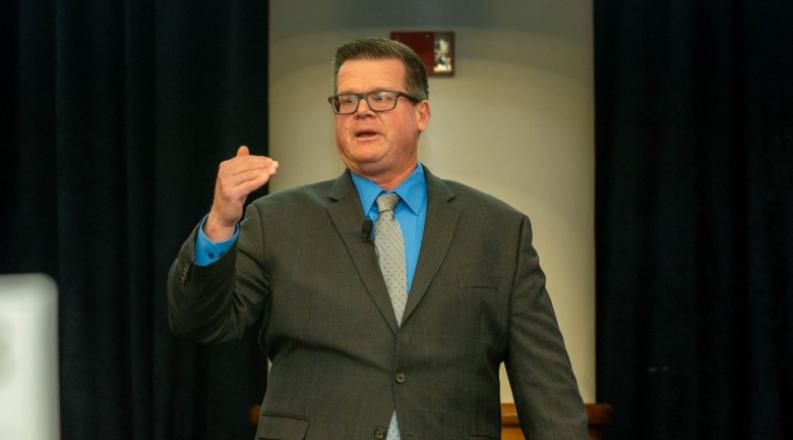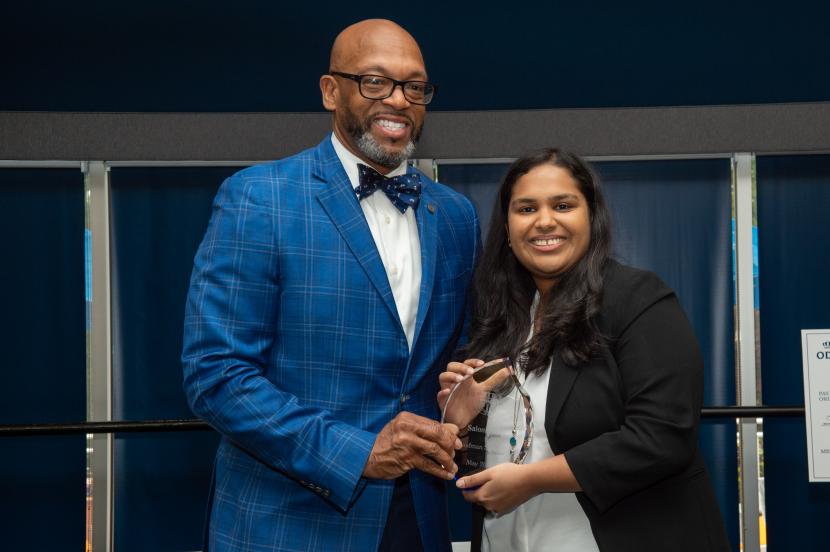"The question is whether we can muddle through this inflationary period or whether it will take a recession to lower prices over the coming months," Bob McNab says.
By Joe Garvey
The state of the U.S. economy continues to dominate the news. Inflation is at a 40-year high. The consumer confidence index dropped to a 16-month low in June. The Federal Reserve Board has begun aggressively hiking interest rates in an effort to tame rising prices. The Dow Jones Industrial Average is down nearly 15% since the start of 2022, eroding families' savings and retirement nest eggs.
To help make sense of this, ODU News asked Bob McNab, chair of the economics department in Old Dominion University's Strome College of Business and director of the Dragas Center for Economic Analysis and Policy, for his take on where things stand, some historical perspective and where we might be headed.
ODU News: How much of an impact, if any, is what the New York Times calls "greedflation" (the belief that dominant corporations are taking advantage of the current situation to raise prices more than they otherwise could) fueling inflation?
McNab: The impact of "greedflation" is harder to quantify than the impact of increases in crude oil prices or other commodities. Given that we had relatively low rates of inflation prior to the pandemic, there is an opportunity for companies to adjust prices upward, but it would be hard to conclude that this is the sole or primary factor for the rise in consumer prices. Prices are up across a wide range of goods and services. Higher margins may occur, but this is a global price shock across multiple industries, so it is hard to argue that there is a synchronized attempt across nations and industries to raise prices.
ODU News: What are the significant differences between what happened in the early 1980s, when the Fed imposed double-digit interest rates, and what's happening today?
McNab: In the 1970s, the unemployment rate declined from a high of 9% in 1975 to a low of 5.8% in 1979 before climbing steadily in the recession of 1981. In 2020, prior to the pandemic, the unemployment rate was 3.5%. By April 2020, the unemployment rate nationally was 14.7% and it has steadily declined since, reaching 3.6% in May 2022. Consumer demand continued to increase after the spring of 2020 and housing values have grown rapidly during the pandemic. The price shocks that are occurring today are a function of disruptions to global supply chains due to COVID-19 and government policies, the rapid increases in public deficit spending and the money supply in response to the collapse of economic activity in the spring of 2020, and geopolitical shocks, to include Russia's invasion of Ukraine. In other words, in February 2020, there was some mild concern that prices might increase in the coming 24 months, but there was no forecast that had inflation above 8% in 2022. In the 1970s, the slowing of economic activity and increasing prices was relatively slow when compared to the rapid changes in economic fortunes due to the COVID-19 pandemic.
ODU News: Are there any parallels between these two eras?
McNab: What is common between the two periods is hardening consumer sentiment about inflation. As consumers form expectations about higher inflation, they act as if higher inflation will occur, shifting consumption decisions and demanding higher wages as compensation for their labor. As the number of job openings relative to job quits remains high, this means employers need to offer higher wages to attract and retain labor, costs that are then pushed forward to consumers. Add increased costs for other goods and services, and now you have a self-fulfilling prophecy. This is why the Federal Reserve has finally reacted strongly as it had hoped inflation would moderate but instead allowed it to permeate economic decisions. Now it has to rapidly raise the cost of money to combat inflationary expectations, even if it risks inducing a recession as a result.
ODU News: Prices of everything seem to be higher, but are there any sectors where they've been relatively stable? Are there any sectors where we could see prices moderate more quickly than others?
McNab: Prices are up, though some goods (durables, food, energy, housing) are up much more than others (services).
The open question is what gets us through this period of inflation. Of course, increasing interest rates may break inflationary expectations, but that may have adverse side effects, like a contraction in economic activity. Is the cure (higher rates) worse than the disease (inflation)? In the short run, people will find that real estate demand will decline, leading to an outright contraction in housing values. Equities will also come under pressure if people change their consumption decisions, which would keep pushing markets downward. An increase in unemployment would place more families at the margins of society and strain social safety nets.
But significantly higher inflation would be much worse over time. We only need to look at countries where inflation is persistent to see how it undermines savings, investments and long-term decision making. The longer you wait, the more painful the cure. So we are in for a series of interest rate increases this year.
ODU News: People are understandably focused on inflation, and the stock market is down. But the unemployment rate is near its historic low. Are there any other aspects of the economy that should give people some confidence going forward?
McNab: Not all the news in the economy is bad. Retail sales are above pre-pandemic levels. Anyone in the labor force who wants a job is likely to find one. For all the disruptions to supply chains, markets are relatively full. The question is whether we can muddle through this inflationary period or whether it will take a recession to lower prices over the coming months. Given the number of shocks that we have endured over the last 24-plus months, I would not discount another shock (or two) from happening, finally tipping us into a recession in 2023. For now, I would say the odds are 50-50 over the next 12 months, but if there is one lesson from the pandemic, it is that economic conditions can change rapidly.
Related News Stories
ODU’s Midyear Economic Forecast Predicts a Slowing Economy for the Rest of 2022
ODU’s Dragas Center economists anticipate rising inflation, but defense spending and the hotel industry recovery offer silver linings. (More)
Strome College's Saloni Jain Named Kaufman Award Winner at Student Honors and Awards Dinner
The Outstanding University Scholar, Evon-Broderick honorees and Provost’s Awards for Outstanding Undergraduate Researcher were also announced. (More)
Class of 2022: Lack of a High School Diploma Strengthened Elizabeth Silerio’s Resolve
Circumstances led her to pursue a GED, which motivated her to excel in college. She’ll graduate with the Top Marketing Student Award, which was voted on by department faculty. (More)






